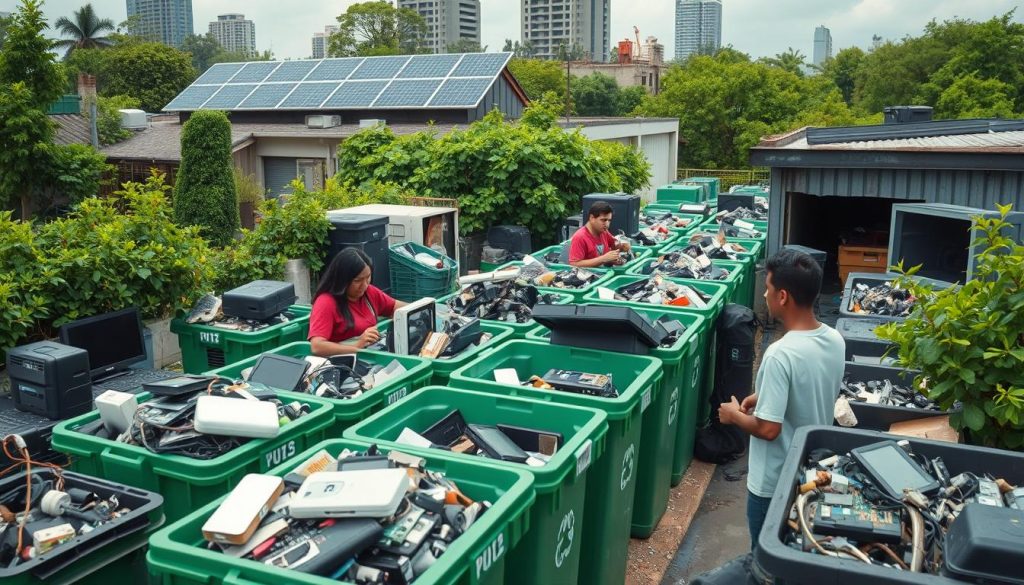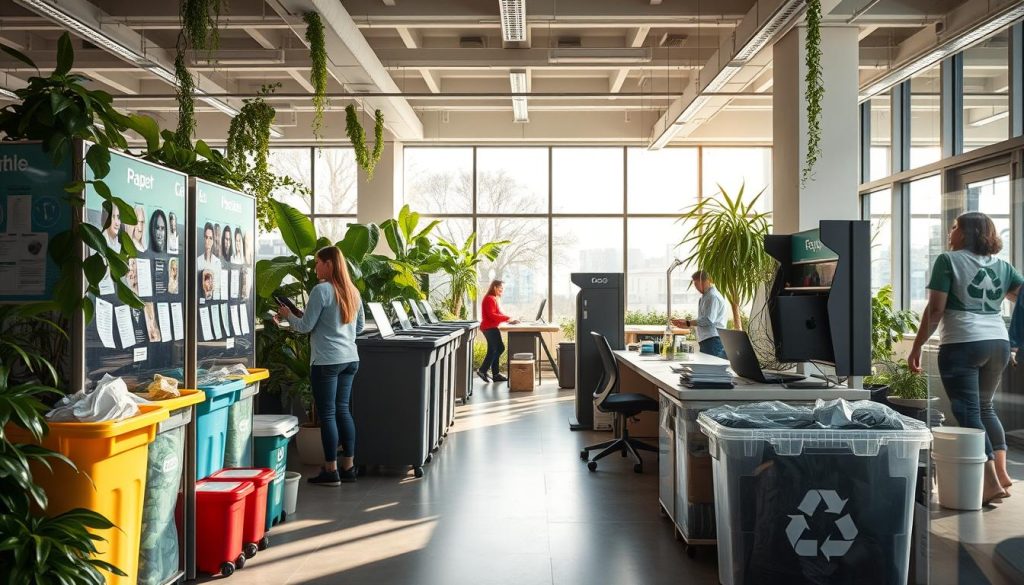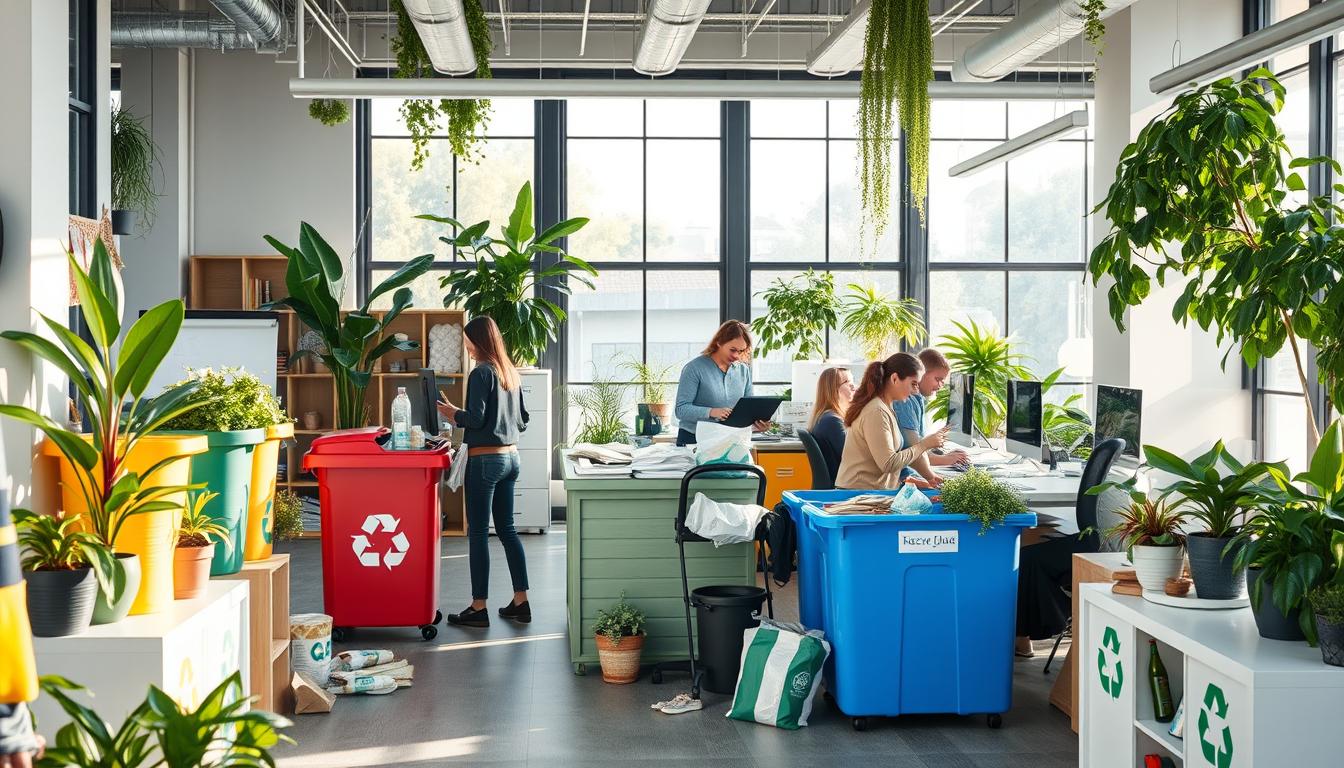I’ve noticed a big change in offices across the United States. More companies are starting recycling programs as part of their green goals. It’s great to see offices becoming more eco-friendly.
These recycling efforts do more than just sort trash. They change how we view waste at work. By using smart recycling, businesses are making a big difference for the environment.
Offices are recycling paper and disposing of old electronics in many ways. It’s good for the planet and also helps businesses grow. Let’s look at how these efforts are changing our workplaces for the better.
The Importance of Office Recycling Initiatives
I’ve seen how office recycling can change a workplace. These programs do more than sort trash. They are a powerful tool for change. By starting waste management programs, companies can lessen their environmental footprint and save money.
One big benefit is the rise in employee awareness about the environment. When staff recycle, they start to think about their daily actions. This awareness often spreads to their personal lives and community.
Recycling also saves money. By not throwing waste in landfills, companies can cut disposal costs. They might even make money from recyclables. I’ve seen big savings, especially for big companies.
Recycling shows a company cares about the planet. This can make a company look good to customers, partners, and job seekers. I’ve seen how this can open up new business chances and attract better talent.
- Reduces environmental impact
- Cuts operational costs
- Boosts employee morale
- Enhances corporate image
In short, office recycling is a win for everyone. It helps the planet, saves money, and makes employees happier. As companies focus more on being green, recycling will become a key part of work culture.
Understanding Waste Management Programs in the Workplace
I’ve seen how waste management programs change office environments. They are key to making workplaces sustainable and less harmful to the environment. Let’s explore what makes effective waste management in offices.
Types of Waste Generated in Offices
Offices create different types of waste. Paper is the most common, followed by plastic from packaging and food. E-waste from old electronics and toner cartridges is also a big part. Knowing these waste types is vital for setting up recycling bins in offices.
Implementing Effective Waste Segregation
Good waste segregation is the heart of waste management programs. Clear labels on recycling bins for offices make a big difference. It’s important to have separate bins for paper, plastics, and electronics. Training employees on how to dispose of waste correctly is crucial for keeping waste streams clean.
| Waste Type | Recycling Bin Color | Common Items |
|---|---|---|
| Paper | Blue | Printer paper, newspapers, magazines |
| Plastic | Yellow | Water bottles, food containers |
| E-waste | Red | Old computers, phones, cables |
Benefits of a Well-Structured Waste Management Program
Comprehensive waste management programs have many benefits. They reduce landfill waste, lower office costs, and boost the company’s green image. I’ve seen that employees feel more involved and eco-conscious when they take part in these efforts.
By understanding and using effective waste management strategies, offices can greatly lessen their environmental impact. This creates a more sustainable workplace culture.
Paper Recycling Drives: Reducing Our Carbon Footprint
I’ve seen how paper recycling drives change an office’s environmental impact. These efforts are key in reducing waste and lowering our carbon footprint. We make it simple for everyone to recycle by setting up paper collection points.
Successful drives often include:
- Placing recycling bins near printers and desks
- Educating staff on what can and can’t be recycled
- Partnering with local recycling facilities
- Tracking recycling metrics to measure progress
Tracking our recycling is crucial. It shows us our impact and helps us set better goals. Using simple spreadsheets or software makes tracking easy.
| Metric | Before Drive | After Drive | Improvement |
|---|---|---|---|
| Paper Waste (lbs/month) | 500 | 200 | 60% reduction |
| Recycling Rate | 30% | 75% | 45% increase |
| CO2 Emissions (lbs/month) | 1000 | 400 | 60% reduction |
By using these strategies and tracking our progress, we’ve seen big improvements. It’s incredible how small changes can make a big difference for our planet.
E-Waste Disposal Initiatives: Tackling the Digital Age’s Refuse

In our tech-driven world, e-waste disposal initiatives are crucial for a greener future. Offices generate mountains of electronic waste. It’s time we tackle this growing problem head-on.
Identifying E-Waste in the Office
E-waste isn’t just old computers. It includes printers, phones, cables, and even coffee makers. I’ve learned to spot these items and set up collection points. This makes it easier for everyone to dispose of e-waste properly.
Secure Data Destruction Methods
Data security is a top concern. I always ensure we use certified data destruction services. They wipe hard drives clean or shred them completely. This protects sensitive information and gives us peace of mind.
Partnering with Certified E-Waste Recyclers
Working with certified recyclers is key. These partners break down e-waste safely, recovering valuable materials. They also dispose of hazardous components properly. It’s a win for the environment and our bottom line.
Recycling education and training play a big role in our success. I’ve implemented regular sessions to keep staff informed about e-waste management. This has boosted participation and improved our recycling rates significantly.
By focusing on these areas, we’ve made great strides in our e-waste disposal initiatives. It’s rewarding to see our office contribute to a more sustainable future.
Boosting Employee Environmental Awareness
I think it’s key to raise employee environmental awareness for office recycling success. By teaching recycling, we can build a team that supports green practices.
Interactive workshops are a great strategy. They let employees practice sorting waste and learn about recycling. They see how their actions affect the environment and how they can help.
Visual aids like infographics and posters are also effective. They remind everyone of recycling rules. Colorful, simple graphics help show what goes where.
| Awareness Activity | Impact on Employee Engagement | Environmental Benefit |
|---|---|---|
| Interactive Workshops | High participation rates | Improved waste sorting accuracy |
| Visual Aids | Increased daily awareness | Reduced contamination in recycling |
| Green Team Initiatives | Fostered peer-to-peer learning | Expanded recycling program scope |
Creating a ‘Green Team’ is a smart move. This team of eco-conscious employees can inspire others. They can plan events like recycling challenges or eco-fairs. These activities make going green fun and engaging for all.
Aligning Office Recycling with Corporate Sustainability Goals
Office recycling is key to meeting corporate sustainability goals. Setting clear targets and promoting environmental responsibility can lead to a greener future.
Setting Measurable Recycling Targets
To match recycling with sustainability goals, set specific, measurable targets. Start with a waste audit to know your current recycling rates. Then, set goals for reducing waste and increasing recycling.
Integrating Recycling into Company Culture
Building a sustainable culture is vital for recycling success. Educate employees on waste sorting, provide easy recycling bins, and reward recycling achievements. This way, sustainability becomes a core company value.
Reporting and Transparency in Sustainability Efforts
It’s important to report recycling metrics clearly and regularly. Use a system to track and analyze recycling data. Share this data with employees and stakeholders through reports and newsletters. This keeps everyone informed and involved in environmental efforts.
| Recycling Metric | Tracking Method | Reporting Frequency |
|---|---|---|
| Total waste diverted from landfill | Waste hauler reports | Monthly |
| Recycling rate | Weight of recycled materials / Total waste | Quarterly |
| Cost savings from recycling | Reduced waste disposal fees | Annually |
Recycling Incentives for Employees: Encouraging Participation
Offering recycling incentives for employees is a great way to boost participation in office sustainability efforts. By creating exciting rewards, we can spark employee environmental awareness. This makes recycling a fun part of daily work life.
One effective approach is to set up a points system. Employees earn points for each recycling action they take. These points can be redeemed for various perks, like extra break time or prime parking spots. This system not only encourages recycling but also creates a sense of friendly competition among coworkers.
Another idea is to organize team-based recycling challenges. Departments compete to see who can recycle the most in a given period. The winning team gets a group reward, such as a catered lunch or an afternoon off. This fosters teamwork and makes recycling a shared goal.
Recognition programs are also powerful motivators. We can highlight top recyclers in company newsletters or on office bulletin boards. This public acknowledgment can inspire others to step up their recycling game.
| Incentive Type | Example | Impact |
|---|---|---|
| Individual Rewards | Points system for perks | Increases personal motivation |
| Team Challenges | Departmental recycling contests | Promotes group effort |
| Recognition Programs | Employee of the Month for recycling | Boosts morale and participation |
By implementing these incentives, we can create a culture where recycling becomes second nature. It’s a win-win situation: employees feel valued for their efforts, and the company moves closer to its sustainability goals.
Tracking Success: Recycling Metrics and Analytics
![]()
Measuring the impact of our office recycling is key for better results. By using good recycling metrics and tracking, we can see how well our programs work. This helps us make choices based on facts.
Key performance indicators (KPIs) are important for checking our recycling. I suggest tracking these:
- Total waste generated
- Recycling rate
- Contamination rate
- Cost savings from reduced waste disposal
To get this data, I mix weight-based measurements with visual checks. Smart bins with sensors give us live info on how full they are and what’s inside. This info helps us fine-tune our waste management and spot where we can do better.
| Metric | 2022 | 2023 | Change |
|---|---|---|---|
| Total Waste (tons) | 150 | 130 | -13.3% |
| Recycling Rate | 45% | 60% | +33.3% |
| Contamination Rate | 15% | 8% | -46.7% |
| Cost Savings | $10,000 | $18,000 | +80% |
By looking at these recycling metrics and seeing how we’ve changed over time, I can spot trends. I can also set achievable goals and celebrate our wins. This way, our waste management keeps getting better and meets our evolving needs.
Designing an Effective Office Recycling Bin System
Creating a good recycling bin system is key for office waste management. I’ll show you how to make a system that gets everyone involved and makes recycling easier.
Optimal Placement of Recycling Bins
Where you put recycling bins matters a lot. Place them in busy spots like break rooms, near printers, and by exits. This makes recycling easy and gets more people to participate.
Clear Labeling and Instructions
It’s important to have clear labels on recycling bins. Use pictures and simple words on each bin. For example, a paper bin might have a paper image and say “Paper Only – No Food Waste.” This helps avoid mistakes and makes recycling better.
Choosing the Right Bin Types
Each material needs its own bin type. Use bins with narrow slots for paper to keep out big items. For bottles and cans, choose bins with round openings. Use colors to help people tell bins apart:
- Blue for paper
- Green for bottles and cans
- Brown for compostables
- Black for general waste
By following these tips, you’ll have a recycling system that works well. It will help your office manage waste better and be more eco-friendly.
Office Recycling Initiatives: Best Practices and Case Studies

I’ve seen some amazing office recycling initiatives that have made a real impact. Let’s look at a few standout examples that can inspire your own corporate sustainability goals.
Google’s zero-waste program is a game-changer. They’ve achieved an impressive 91% diversion rate from landfills and incinerators. Their secret? Custom recycling stations with clear labels and regular employee education sessions.
Patagonia takes a different approach. They focus on reducing waste before it’s created. Their offices use reusable dishes and utensils, eliminating single-use plastics. They’ve also set up repair stations for employees’ personal items, promoting a fix-it-first mentality.
Microsoft’s e-waste recycling program is worth noting. They partner with certified recyclers to ensure proper disposal of electronic waste. Plus, they host annual e-waste collection events for employees’ personal electronics.
| Company | Initiative | Result |
|---|---|---|
| Custom recycling stations | 91% diversion rate | |
| Patagonia | Reusable items, repair stations | Significant reduction in single-use waste |
| Microsoft | E-waste recycling program | Proper disposal of electronics, employee engagement |
These case studies show that successful office recycling initiatives require clear communication, employee engagement, and a commitment to sustainability. By learning from these examples, you can create a recycling program that aligns with your corporate sustainability goals and makes a real difference.
The Future of Office Recycling: Innovations and Trends
I’m excited about the future of office recycling. New technologies are changing how we handle waste at work. Imagine bins that sort items on their own or apps that track recycling progress. These innovations make it easier for everyone to pitch in.
The circular economy is becoming more popular in offices. It’s about reusing and repurposing materials instead of throwing them away. Companies are finding creative ways to give new life to old office supplies and furniture. This approach cuts down on waste and saves money.
E-waste disposal initiatives are evolving too. As our gadgets get smarter, so do our recycling methods. We’re seeing new techniques to recover precious metals from old electronics. This not only reduces waste but also conserves valuable resources.
Looking ahead, I predict office recycling will become more integrated with daily work life. We might see rewards programs for eco-friendly actions or buildings designed with sustainability at their core. The future of workplace recycling is bright, and I’m excited to see what comes next.

